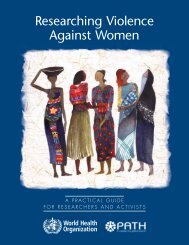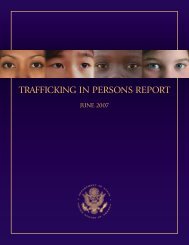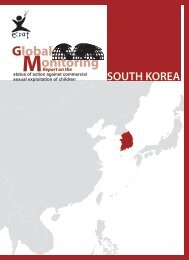Download PDF - Violence Against Children - East Asia and the ...
Download PDF - Violence Against Children - East Asia and the ...
Download PDF - Violence Against Children - East Asia and the ...
You also want an ePaper? Increase the reach of your titles
YUMPU automatically turns print PDFs into web optimized ePapers that Google loves.
Indonesia<br />
Child protection concerns identified<br />
The extent to which anxiety, psychosomatic<br />
complaints, aggression, behavioural disorders<br />
or school failures are linked with <strong>the</strong> direct<br />
or indirect consequences of conflict, is not<br />
clearly known. In what way could such<br />
problems be addressed? It is clear that<br />
educational programs are needed that can<br />
offset stress, <strong>and</strong> simultaneously streng<strong>the</strong>n<br />
<strong>the</strong> building of peace.<br />
Helping communities torn by (or at risk of)<br />
violence to recognise <strong>and</strong> accept<br />
communities that hold different views to<br />
<strong>the</strong>ir own is critical. 8 This is especially true<br />
for children, who can be actively involved in<br />
ei<strong>the</strong>r reconciliation or retribution as old<br />
conflicts re-emerge with a new generation of<br />
protagonists. For <strong>the</strong> sake of children, both<br />
now <strong>and</strong> in <strong>the</strong> future, <strong>the</strong> cycle of violence<br />
must be broken. Education also helps<br />
children affected by conflict to envisage, <strong>and</strong><br />
prepare <strong>the</strong>mselves for, alternative futures.<br />
<strong>Children</strong> displaced <strong>and</strong> affected by armed<br />
conflict, <strong>and</strong> now living in camps or resettled<br />
areas, are especially marginalised <strong>and</strong> at risk<br />
of exploitation. 9 The existence of IDPs in<br />
West Kalimantan is a fur<strong>the</strong>r legacy of <strong>the</strong><br />
conflict: <strong>the</strong> Government’s response to<br />
violent outbreaks in <strong>the</strong> last five years has<br />
partially involved relocating hundreds of<br />
families away from areas of tension to camps<br />
ei<strong>the</strong>r in quieter, less accessible areas, or in<br />
<strong>the</strong> main city closely supervised <strong>and</strong><br />
surrounded by ethnic groups on <strong>the</strong> “o<strong>the</strong>r<br />
side” of <strong>the</strong> conflict. They are safe in <strong>the</strong>se<br />
areas but have few basic services <strong>and</strong> few<br />
options. 10 This has led to o<strong>the</strong>r child<br />
protection issues.<br />
The community of IDPs is able to subsist,<br />
but <strong>the</strong>ir quality of life is limited. In terms of<br />
education, in Marhaban camp, special<br />
provision to accommodate this group was<br />
not made through <strong>the</strong> local government<br />
school. There was no school in <strong>the</strong> camp<br />
when it was established four years ago <strong>and</strong><br />
children did not feel safe to go to <strong>the</strong> school<br />
on offer. Thus, <strong>the</strong> children’s right to<br />
education <strong>and</strong> development was<br />
compromised as a result of <strong>the</strong> conflict. (This<br />
does not apply to camps in Pontianak city,<br />
where children have access to school <strong>and</strong><br />
<strong>the</strong>ir parents have access to jobs.)<br />
There has been a real danger that <strong>the</strong><br />
children’s minority status would promote a<br />
sub-class, <strong>and</strong> place <strong>the</strong>m at risk of being<br />
trafficked <strong>and</strong>/or involved in hazardous work<br />
at a young age. <strong>Children</strong> have been subject to<br />
threats of violence from <strong>the</strong> children of <strong>the</strong><br />
local community, for whom <strong>the</strong> presence of<br />
<strong>the</strong> IDP camp has been a source of tension.<br />
While efforts have been undertaken to<br />
address issues of access, a dedicated position<br />
to promote government response on child<br />
protection is needed for fur<strong>the</strong>r progress to<br />
be made. 11<br />
In this West Kalimantan IDP community,<br />
boys from <strong>the</strong> age of 13 work in manual jobs.<br />
Girls are married at <strong>the</strong> age of 14–16; family<br />
size is reportedly five children. <strong>Children</strong><br />
<strong>the</strong>mselves have dreams of higher education<br />
<strong>and</strong> of being successful in a range of areas.<br />
The older youths (aged 16+) have a more<br />
negative view, thinking that <strong>the</strong>ir dreams<br />
will fail because of <strong>the</strong> lack of opportunity<br />
<strong>and</strong> money.<br />
In conflict areas across Indonesia, children<br />
are not only affected by <strong>the</strong> conflict, but<br />
some are involved directly in fighting. Groups<br />
of combatants reportedly recruit children<br />
with promises of food or payment. The tasks<br />
<strong>the</strong>y are called upon to carry out put <strong>the</strong>m at<br />
risk <strong>and</strong> may involve attacking or intimidating<br />
o<strong>the</strong>rs. One 17-year old stated:<br />
“If I knew I was recruited to do this, I would<br />
have refused <strong>and</strong> stayed hungry.” 12<br />
8 One means of raising awareness among faith communities that exclusive behaviours <strong>and</strong> attitudes invite conflict in <strong>the</strong>ir neighbourhoods is “holistic<br />
mapping”. Adaptable to an inter-faith context, it presents methods <strong>and</strong> tools to help faith communities underst<strong>and</strong> <strong>the</strong>ir role <strong>and</strong> place as agents of peace<br />
in a troubled, conflicted country. As well as mapping geographic, social, cultural, economic <strong>and</strong> political features of <strong>the</strong> defined community, it includes a<br />
“conflict map” (of <strong>the</strong> stakeholders, positions <strong>and</strong> interests in <strong>the</strong> conflicts) <strong>and</strong> a “spiritual map” (of relevant <strong>and</strong> competing spiritualities, values, religious<br />
groupings, locations of places of worship, etc.). Narrative mapping puts into words <strong>the</strong> myths, folklore, stories, <strong>and</strong> histories that influence <strong>the</strong> community,<br />
while a “divider <strong>and</strong> connector” map depicts both <strong>the</strong> community’s capacities for causing divisions <strong>and</strong> capacities for making connections.<br />
9 Interview with World Vision Indonesia Reconciliation <strong>and</strong> Peacebuilding Adviser, 2002<br />
10 Note: <strong>the</strong> families of <strong>the</strong> camp are ethnic Madurese (originally from <strong>the</strong> Isl<strong>and</strong> of Madura <strong>and</strong> strong Muslims. The surrounding area is largely populated by<br />
<strong>the</strong> Dayak people who have both Animist <strong>and</strong> Christian elements). A few weeks before <strong>the</strong> author visited <strong>the</strong> camps, three Madurese men travelled 200<br />
kilometres back to l<strong>and</strong> that had been <strong>the</strong>irs prior to ethnic fighting to explore possibilities of selling it. They were killed <strong>and</strong> <strong>the</strong> message of fear, nonacceptance<br />
<strong>and</strong> danger was returned to <strong>the</strong> camp instead.<br />
52<br />
11 Boonpata & Kane, ILO, 2001.<br />
12 Source: Child Soldiers Global Report, International Coalition to Stop <strong>the</strong> Use of Child Soldiers, 2001

















